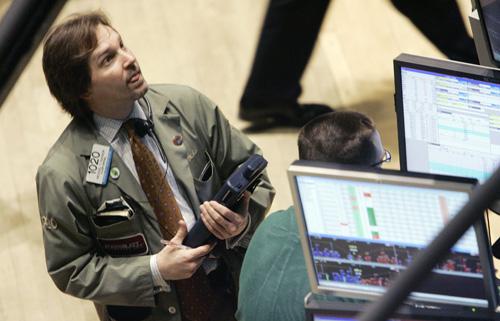Wall Street to receive $200 billion boost from Fed

Trader Michael Raynor checks the numbers as he works on the floor of the New York Stock Exchange Tuesday, March 11, 2008. Wall Street rebounded sharply Tuesday after the Federal Reserve and other central banks said they will pump $200 billion into the fin Richard Drew, The Associated Press
March 12, 2008
NEW YORK – The Fed promised a $200 billion booster shot for ailing markets – and Wall Street answered with its biggest bounce in more than five years.
The Dow Jones industrials shot up more than 416 points, the biggest single-day point gain since July 2002, after the Federal Reserve announced the move as part of a worldwide effort to help struggling banks and mortgage providers.
Hoping to ease the credit crisis, the Fed – acting with the European Central Bank, the Bank of Canada and the Swiss National Bank – agreed to loan investment banks money in exchange for debt, including slumping mortgage-backed securities.
The idea is to create a market for assets that investors have recently been too scared to buy. That freeze in demand had sent asset values plunging and caused huge losses for some of the world’s biggest banks.
After a series of hefty losses in stocks, the market hopes the central banks’ decision Tuesday might be more effective than previous moves – like rate cuts, which had led to initial stock pops that later fizzled.
Get The Daily Illini in your inbox!
“It’s not just a rate cut. I think it’s a very creative way to do financing,” said Anthony Conroy, managing director and head trader for BNY ConvergEx Group. “It shows the Fed is willing to do things that are a little out-of-the-box to shore up credit issues. I really think they went to the heart of the issue.”
Investors certainly seemed to like it: The Dow rose 416.66, or 3.6 percent, to 12,156.81. It was the biggest point jump in the Dow since a 447-point rise on July 29, 2002, and its widest one-day percentage gain since March 2003.
The Dow had lost more than 500 points in the past three sessions and is still down about 2,000 points from its October 2007 record high.
Broader stock indicators also soared. The Standard & Poor’s 500 index rose 47.28, or 3.7 percent, to 1,320.65, while the Nasdaq composite index surged 86.42, or about 4 percent, to 2,255.76.
It was the S&P;’s biggest point gain since April 5, 2001, and the Nasdaq’s biggest since May 8, 2002.
The latest step by the central banks was seen as a direct lifeline to investment banks, which previously couldn’t borrow beyond already established Fed liquidity plans.
The plan basically allows Wall Street’s biggest institutions to put up troubled assets as collateral for loans, use the new capital to make money in the market, and then pay back the loan up to 28 days later.
Though eventually banks would be forced to take the troubled mortgage-backed debt back on their books, the plan still takes short-term pressure off them. Many of these banks will release first-quarter earnings reports next week.
“The big problem has been the financials, and this helps supply money directly to the banks and may take some of the need for aggressive rate cutting off the table,” said Peter Dunay, chief investment strategist at Meridian Equity Partners. “The Fed is basically going to take the bad loans off the banks’ books, and the market seems to be loving that idea.”
The Fed may have avoided dramatically slashing interest rates again when it meets next week. Economists remain concerned about the unrelenting rise in oil prices and the dollar’s weakness, which contribute to inflation – and cutting rates only adds to those pressures.
Government bond prices fell as stocks rallied. The yield on the 10-year Treasury note, which moves opposite its price, spiked to 3.60 percent from 3.46 percent late Monday.
The only sector posting major losses Tuesday was health care, which has been strong in recent months.






